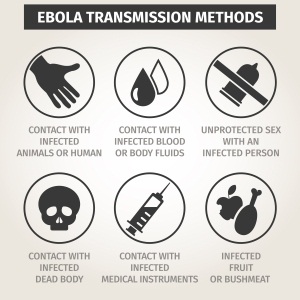
Even as government officials express confidence that researchers know the key facts about Ebola, many questions crucial to preventing an outbreak in the United States remain unanswered, scientists told a workshop at the National Academy's Institute of Medicine in Washington.
Weak science
Virtually all the unknowns have practical consequences, participants emphasised, making it foolish and perhaps dangerous to base policy on weak science.
For instance, virologists believe that Ebola is spread when people come in contact with the virus-laden bodily fluids of those who are already sick and then touch their eyes, nose or mouth, allowing the virus to pass through mucous membranes and enter the bloodstream.
But penetration through intact skin has not been definitively ruled out, said hemorrhagic-fever expert Thomas Ksiarek of the University of Texas Medical Branch (UTMB), who co-led a session on Ebola's transmission routes.
Read: Ebola can jump from animals to people in Africa
"Does bleach or hand sanitizer," which people in West Africa are using to protect themselves from Ebola, "make the skin more susceptible" to being penetrated by the virus?, Peters wondered. "It's a question that has to be asked."
Another crucial question is whether the virus can be spread by people who do not show symptoms. For months public health officials in the United States and elsewhere have insisted it cannot.
But the possibility of such "subclinical transmission" remains very much open, said Dr. Andrew Pavia, chief of paediatric infectious diseases at the University of Utah.
Incubation period
Nor do experts know whether the infectious dose of virus depends on how it enters the body, Pavia said.
Also unknown is whether the time between exposure to Ebola and the appearance of symptoms depends on which bodily fluids someone contacted. If it does, then someone exposed through, say, saliva rather than blood might incubate the virus for longer than the 21 days officials have repeatedly said is the outer limit of the incubation period.
That was the longest incubation time during the 1976 Ebola outbreak, said Dr. C.J. Peters, a field virologist at UTMB. But "I would guess that 5 percent of people" can transmit the virus after incubating it for more than three weeks, said Peters, whose battle against the Ebola outbreak in a monkey colony in Virginia was recounted in Richard Preston's 1994 book "The Hot Zone."
Read: Can your pet give you Ebola?
Health officials emphasize the importance of taking the temperature of those exposed to Ebola, since people are not thought to be infectious until they run a fever of 100.4 F. (38 C). But at what temperature patients start shedding virus is not definitively known, said Dr. Michael Hodgson, chief medical officer of the Occupational Safety and Health Administration.
Environmental mysteries also remain. Scientists do not know whether foam, gas, or liquid decontaminants are most effective for cleaning surfaces that might harbor Ebola. Nor do they know whether it can survive in sewers where, said Paul Lemieux of the National Homeland Security Research Centre at the Environmental Protection Agency, rats "might pick it up."
Read more:
Inhaled Ebola vaccine protects monkeys
Ebola risk from animals higher than thought
What happens to Ebola medical waste?
Image: Ways of transmitting Ebola from Shutterstock




 Publications
Publications
 Partners
Partners










